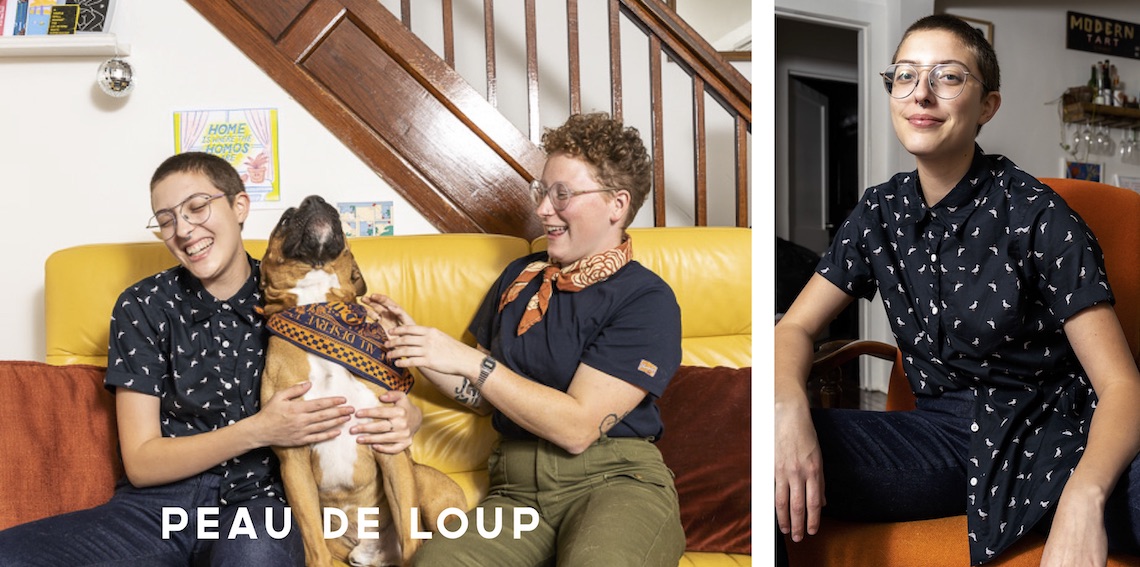Demand for fashion that doesn’t conform to traditional notions of the gender binary — sometimes billed as genderless, gender neutral or unisex — is on the rise. Big brands like Fred Segal and Uniqlo have launched genderless collections in the last year.
But often, genderless designs aren’t radically different from typical gendered clothing, with only the labels and marketing changing. LGBTQ activists have called out that clothes marketed by brands as genderless is often men’s and women’s clothing lumped together and designed in a shapeless and unexciting way, as non-binary cartoonist Mattie Lubchansky pointed out last year.
But smaller independent designers are working to find methods for designing gender non-conforming fashion that avoids the “brown sack” problem. Adelle Renaud, a Vancouver-based designer and founder of the gender-neutral fashion brand Peau de Loup, thought about what she, as a gender non-conforming person, wanted out of her clothes as she began developing her brand back in 2012. Her clothes are inspired by menswear but made for both masculine and feminine body types.
“Many of our consumers don’t land in the binary,” Renaud said, pointing to the audience she’s cultivated with a queer-friendly Instagram presence and relationships with queer influencers. Renaud said she frequently communicates with customers on Instagram to gauge what they want out of their clothes. “Many want to wear menswear styles, but most menswear isn’t made for their bodies.”
The typical masculine body type is wider shoulders and narrower hips, while the typical feminine body type is the opposite in traditional fashion designs. Peau de Loup’s latest collection, a line of denim released on its online store last week, is made with a boxy hip-deemphasizing cut and can fit on both traditionally masculine and feminine body types. The brand’s shirts are slimmer at the shoulders with a similarly boxy cut for the same reason. The 10-year-old company has grown 32% year-over-year in 2022, and is on track to hit $1 million in revenue by the end of the year. It’s been worn by LGBTQ celebrities like Lena Waithe and Ruby Rose.
“It even goes into materials,” Renaud said. “Womenswear materials tend to be stretchier, they tend to cling. We use sturdier menswear fabric because many customers don’t want a super feminine look.”

One of the biggest hurdles when designing a genderless collection is in sizing. Sizing standards differ widely between traditionally gendered clothing. Men’s pants, for example, are often listed in waistline inches, while women’s pants use abstract numbers typically ranging from 0-24.
And larger companies are showing interest in smaller brands in this space, due to the breakthroughs they’ve made. Peau de Loup had a partnership with Urban Outfitters over the summer, selling its genderless clothing in a new, dedicated section of its website labeled non-binary.
According to Renaud, the sell-through was fast and the reception was positive. Some large retailers like Urban Outfitters are making more progress in genderless fashion than others. Pacsun, for instance, launched a dedicated unisex subbrand last year called Colour Range, which has continued to introduce new products.
Alison Strumeyer, co-founder and CEO of 6-month-old unisex sock brand Doublesoul, said sizing was one of the first things she and her team tackled when developing products.
“We work with a factory in Turkey, and when we came to them with our idea, they were confused,” said Strumeyer. “They had their standard men’s and women’s socks. When you go to buy socks online, the first thing you do is select men’s or women’s. But it’s just a sock. Why does it have to be gendered?”
Doublesoul’s socks come in four sizes, which the brand labels simply as Size I, Size II, Size III and Size IV. Size I can fit the equivalent of a standard women’s size 4 sock, while Size IV can fit the equivalent of a standard size 14 men’s sock. Doublesoul puts the size guide for its unique sizes front and center on its online store. The guide includes conversions for people used to standard gendered sizes — a necessary evil to introduce them to the new system, Strumeyer said. She hopes the step won’t be necessary for the future.
H&M’s current iteration of the Unisex Shop on its site, meanwhile, collects items from the men’s and women’s collections, showing each piece only modeled on men or women and selling them in standard gendered sizing.
“There’s a strong market for gender-neutral sizing,” Strutmeyer said. “When we sent out the first product batch to influencers, it went pretty viral. We had an 85% posting rate.”
And that market is only getting stronger. Industry projections suggest the global market for unisex or genderless fashion will grow by 4.5% annually, reaching $3.2 billion by 2028.
“Many companies just dip their feet into this during Pride Month and then forget about it,” Renaud said. “And retailers [have a] whole system based around men’s and women’s clothing. They have a men’s buyer and women’s buyer, a men’s section and a women’s section. They’re not set up to take the risk.”




